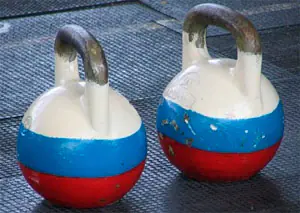It is important to understand: the kettlebell lifting technique we previously mastered (in previous articles) is not the whole theory of kettlebell lifting... Many beginners, having attended just a few classes, naively believe: “Oh, kettlebell lifting is so easy! And the whole technique of kettlebell lifting is just two movements - how easy it is. I learned everything, I know everything and now I can do everything, I’ll pull weights at home and pump up my huge shoulders!”… And subsequently, having only this meager knowledge behind them and engaging in such “amateur activities,” they receive serious injuries or tear their hearts for life...
Coming into kettlebell biathlon, every new athlete is primarily interested in the technique of lifting the kettlebell. But, having gotten used to it a little and having regularly trained for several months in a row, the kettlebell lifting technique will be mastered by almost 80%, the remaining 20% will be honed and polished through years of painstaking, persistent training. It is important to understand that real success does not come instantly. To achieve something in any sport you need patience, perseverance and perseverance. Well, and, of course, self-control, medical supervision, proper work of trainers and competent organization of the entire educational and training process...
And the main condition for the correct organization of the educational and training process is a gradual increase in the volume and intensity of the load, alternating extreme stress with recovery and rest during the preparatory work. Also, don’t forget about sports nutrition for weight gain. Remember: proper planning of physical activity, as well as developing a nutrition and recovery strategy is already 90% of success!
The volume of the load primarily depends on its correct distribution among activities (depending on the training period), the degree of physical fitness, age and qualifications of those involved.
You can regulate the load in kettlebell lifting, as well as in bodybuilding and fitness:
- number of exercises,
- number of repetitions (lifting and lowering) in one approach,
- number of approaches,
- alternating loads of larger and smaller volumes,
- change in the weight of the weights,
- changing the intervals between sets
- etc.
Training with large volume and intensity loads is of decisive importance for improving sportsmanship, in particular when preparing for any competition. The relationship between these indicators is decisive here.
Intensity, as we said earlier, is a percentage of the maximum result in the snatch or clean and jerk (two key exercises that make up kettlebell biathlon).
In addition, the intensity of training with weights largely depends on the density of the activity, i.e., on the size of the intervals between approaches: the more frequent the approaches, the higher the density of the activity and the greater the intensity of the load.
Thus, a skillful combination of the volume and intensity of the load in each period of the training process is crucial not only for the direct achievement of high sports results, but, first of all, for strengthening the health of those involved and raising the level of general physical development.
It is typical that when training with weights, special exercises with a barbell are often used. The volume and intensity of the load in this case are determined by the same indicators as when performing exercises with weights.
Post Views: 94


